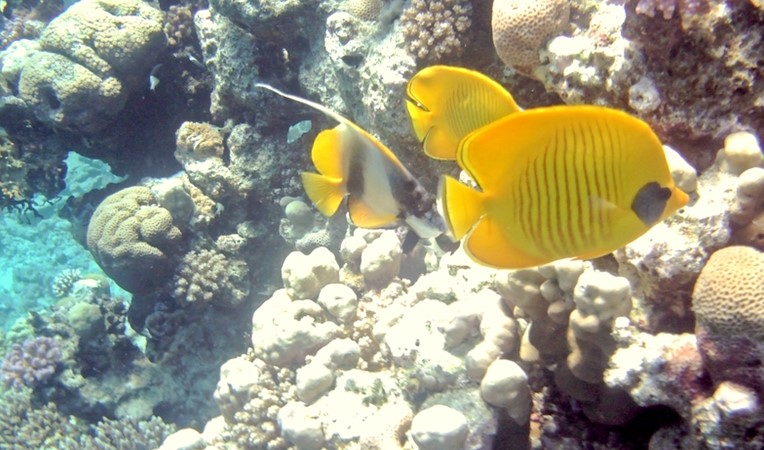The blue-cheeked butterflyfish, Chaetodon
semilarvatus, is a species of butterflyfish (family Chaetodontidae). It is
found in the Red Sea and the Gulf of Aden, at depths of between 3 and 20 m. it
is mostly yellow, with thin slate blue vertical lines on the sides and a slate
blue cheek patch in lieu of the usual black eye stripe of most Chaetodon. This
species is one of the few fish species to have long-term mates. In the wild,
the fish eats hard corals as well as benthic invertebrates.
This is a very popular and widely known butterflyfish. It's an absolutely astounding species with its large size, vibrant colors, and graceful swimming movements. Adults can reach impressive lengths of about 12 inches (30 cm) in the wild, though they are more common at about 9 inches (23 cm). Its color pattern is also striking. There is a bold dark bluish mask contrasting nicely with its bright yellow body and delicate red stripping. These features have influenced a number of other common names by which it is described, including Masked Butterflyfish, Bluecheek Butterflyfish, Blue Mask Butterflyfish, Red-lined Butterflyfish, Addis Butterflyfish, and Blue Cheeked Butterflyfish.
Butterfly fish or Chaetodontidae are small, colorful fishes with a continuous dorsal fin. Chaetodontidae means Greek bristle teeth and indeed they do have small, brush-like teeth. Most species are active during the day, resting among corals or rocks at night. Some species feed on coral polyps, and these tend to be territorial. When part of a coral is attacked in this way, the surrounding polyps tend to withdraw as far as they can into their protective skeletons. The fish then has to move further along the reef.
There is a dark-blue spot (mask) on the fish' cheek. Many coral butterflies has got mask. They recognize each other as by color as by shape of their eyes. Found usually in pairs hovering close or under Acropora Plate corals in lagoons and seaward reefs rich in coral growth. They feed on benthic invertebrates and polyps of hard corals. Butterflyfishes have very fine hair like teeth that enable them to pick out small organisms inaccessible to most other fish for eating.
Most species of butterfly fish patrol a home range. Those that congregate in large shoals are generally planktivory.












 All
All
 Politics
Politics
 Economy
Economy
 Tourism
Tourism
 Nature
Nature
 Community
Community

